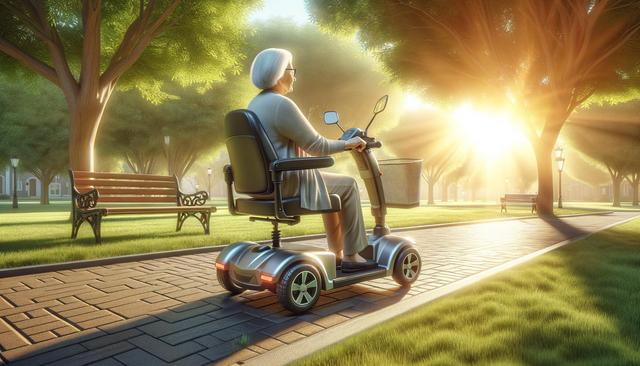Understanding Mobility Scooters and Their Purpose
Mobility scooters are electric-powered vehicles designed to assist individuals with limited mobility. For seniors, these scooters can make a significant difference by providing a reliable and comfortable way to move around both indoors and outdoors. Unlike wheelchairs, mobility scooters are generally easier to use for those who still have partial mobility but find walking long distances challenging. They come in various configurations, typically with three or four wheels, and offer features such as adjustable seating, easy-to-use controls, and rechargeable batteries. The purpose of these scooters is not only to aid in transportation but also to promote a more active and fulfilling lifestyle for seniors.
Many seniors use mobility scooters to navigate shopping centers, parks, or even around their neighborhoods. This practical tool helps reduce the risk of falls and fatigue, especially for those living with conditions such as arthritis, joint pain, or balance issues. By using a scooter, seniors can maintain their independence and continue participating in social activities that might otherwise be difficult.
Types of Mobility Scooters Available
There are several types of mobility scooters tailored to meet specific needs, which can make choosing the right one a bit overwhelming. Generally, scooters fall into three main categories:
- Travel Scooters: Lightweight and compact, ideal for short trips and easy transport.
- Mid-size Scooters: Balance between portability and comfort, suitable for both indoor and outdoor use.
- Heavy-duty Scooters: Built for durability, offering higher weight capacities and longer battery life.
Each type has its advantages. For example, travel scooters are convenient for seniors who frequently visit family or go on trips, as these models often fold or disassemble for storage. Mid-size scooters are versatile, often equipped with better suspension and a higher speed range. Heavy-duty scooters, on the other hand, are designed for those who need extra support and a stable ride on uneven terrain.
When selecting a scooter, seniors should consider factors such as their typical travel distance, terrain, physical condition, and whether the scooter needs to be transportable by car. Consulting with a healthcare professional or mobility specialist can also help narrow down the most suitable model.
Key Features and Considerations
Mobility scooters come with a range of features that enhance user experience and safety. These features can vary greatly among models, so it’s important to understand which ones are most relevant to the user’s lifestyle. Common features include:
- Swivel seats for easy access
- Adjustable tillers for better control
- Battery indicators for monitoring power levels
- Headlights and rearview mirrors for safety
- Suspension systems for a smoother ride
Another important consideration is the scooter’s weight capacity. Most standard models support between 250 to 350 pounds, while heavy-duty versions can accommodate up to 500 pounds. Battery range is also essential—some scooters can travel a few miles on a single charge, while others can go over 20 miles. Seniors who plan to use their scooter for longer distances should prioritize models with extended battery life.
Comfort is a top priority. Look for padded seats, ergonomic handlebars, and sufficient legroom. Some models even offer weather-resistant components or storage baskets for added convenience. These features not only improve the user’s experience but also contribute to long-term usability and satisfaction.
Benefits to Seniors’ Lifestyle and Well-being
The impact of mobility scooters on a senior’s quality of life can be significant. By facilitating greater mobility, these scooters help users maintain a sense of autonomy and engagement with their environment. This can lead to improved mental health, as seniors feel more empowered and less isolated. Social interaction becomes easier, whether it’s visiting friends, attending community events, or simply enjoying a stroll in the park.
Physical health can also benefit. While mobility scooters do not replace exercise, they reduce strain on joints and muscles, making daily activities more manageable. For seniors recovering from surgery or managing chronic conditions, scooters serve as a transitional aid that supports daily function without overexertion.
Additionally, mobility scooters can reduce reliance on caregivers, allowing seniors to perform tasks such as grocery shopping or attending appointments independently. This not only benefits the user but also provides peace of mind to family members and caretakers, knowing that mobility needs are being met safely and efficiently.
Tips for Safe and Responsible Use
Safety is paramount when using a mobility scooter. Seniors should become familiar with their scooter’s controls and capabilities before venturing into public spaces. Basic training or guidance from a professional can help users learn how to navigate various environments confidently. Here are a few essential safety tips:
- Always charge the battery fully before use
- Use sidewalks and designated paths whenever possible
- Adjust speed appropriately for the environment
- Be cautious on ramps and uneven surfaces
- Keep the scooter clean and regularly maintained
Many scooters come with safety features such as automatic braking systems and anti-tip wheels. Even so, users should practice good judgment and avoid distractions while operating the device. Wearing a reflective vest or installing lights can increase visibility, especially in low-light conditions.
Proper maintenance is also critical. Regularly inspect tires, brakes, and battery health. Keeping the scooter in good condition not only ensures longevity but also prevents unexpected breakdowns. Most manufacturers offer user manuals and support services to assist with maintenance schedules and troubleshooting.
Conclusion: Empowering Seniors Through Mobility
Mobility scooters are more than just a mode of transport—they represent independence, safety, and an enhanced quality of life for seniors. Whether used for daily errands or leisurely outings, these devices can make everyday life more accessible and enjoyable. By choosing a scooter that fits personal needs and using it responsibly, seniors can continue to engage with their communities, maintain their routines, and live comfortably on their own terms.


